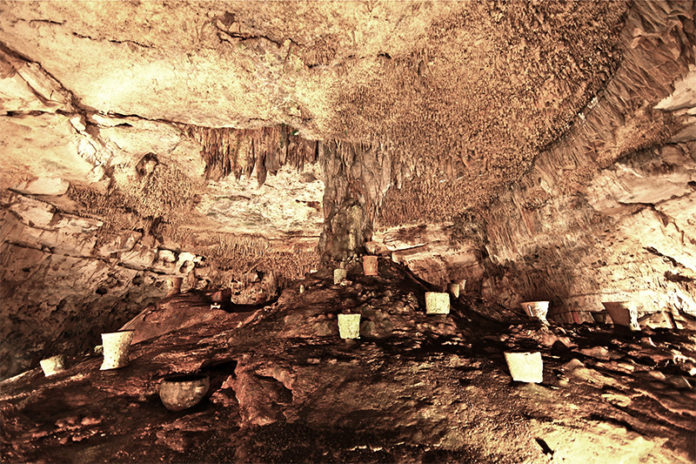This article was featured in Travel Thru History and Ancient Origins.
Caves are central to world cultures’ cosmologies, used by humans from the dawn of time. They are places where benevolent and malevolent deities, protectors and disruptors of communities and individuals’ lives, associated with powerful natural forces. They are the home of ancestors believed to dwell in caves.
Balankanche’s cave is located 2.5mi/3.9Km southwest of Chichen Itza archaeological site, near the town of Pistè.The cave’s proximity to this major site underline the fact that it was an integral part of Uuc Yab’nal, Chichen Itza ancient name in the Maya Itza language, for religious rituals and ceremonies. Partial map below from J. Kelly, 1993:27
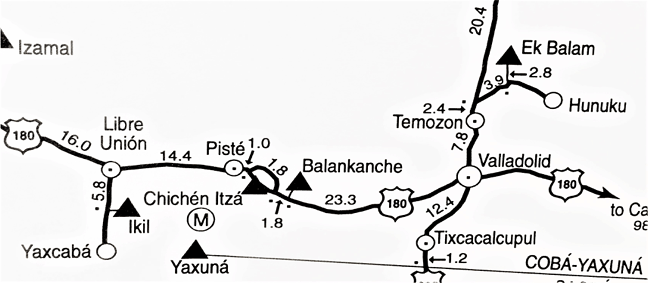
Caves provide an essentially different kind of setting than surface architecture. Among known caves in the Maya lowlands, Balankanche received less attention than it deserves, and is integral to the great complex of Chichen Itza. The cave is referred to as the “Throne of the Tiger Priest” by E.Willis Andrews, in his 1970 archeological report.
Chichén Itzá ancient name, Uuc Yab’nal, translates as the “Mouth of the Well of the Itzaes”. The name Chichen is made of the Maya-Yucatec words chi that means mouth, and chen for well. Chichen therefore means “the mouth of the well” (Román Piña Chan, 1980). Its history spans from Late to the post-Classic (800>1300BC). The large sacred cenote (sink hole), was dedicated to rituals, while the other, Xtoloc (iguana) among other cenotes in the vicinity, supplied water to the community.
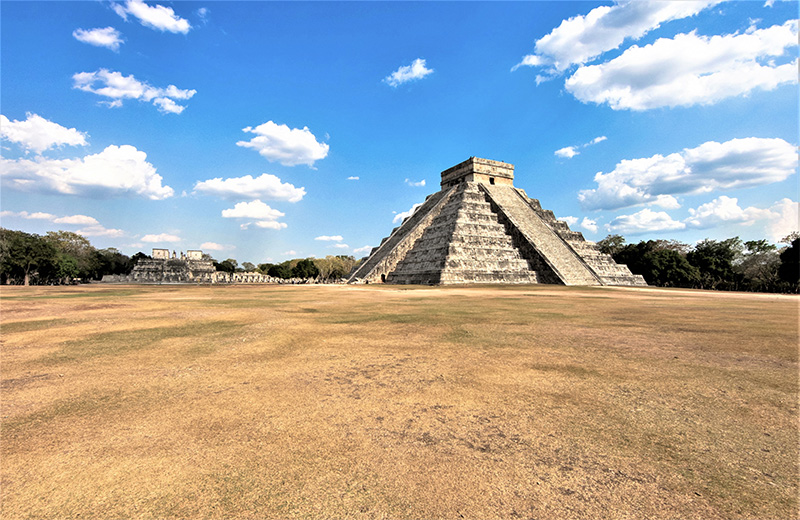
In 1958, Josè Humberto Gomez past time had been, for over ten years, the exploration of the cave. After this much time exploring, he discovered what seemed to be a false section of the wall of one of the chambers. On examination, it turned out to be crude masonry sealed with mortar that covered a small access to the newly discovered chambers. Previous archaeological expeditions had come within feet of the wall, sealed about 850AD, not realizing what lay beyond.
The cave significance can fully be understood when set within the monumental secular site above ground, integrating the religious seat of power underground. The interaction between the surface elements and those of the cave, shed an unusual light, beyond architectural art, on the life of the great metropolis.
Balankanche “second tenant” deity in the cave is Tlaloc, the Toltec god of rain, storm, lightning and thunder. The deity originates from Tula on the central plateau of Mexico and is associated with caves, cenotes, springs and mountain tops, all believed to be guardians and holders of rain in past and present Mesoamerican mythologies.
Tlaloc and Xipe Totec censers made of ceramic and stone respectively, found in the cave, are deities from the central plateau of Mexico. While relatively little is known about Yucatán deities and fertility gods, points to the fact that the cave may be considered the focus of a folk cult, before Toltec arrival (Kurjack, 2006).
But what are cenotes”? They are mirrors of two worlds. To this day they are believed to be Cha’ak’s dwellings and holders of life, as they are, given the scarcity of surface water in the Yucatán during the dry season. The mythical power of the god of water, and the milpero (peasant) relationship to maize is profoundly mystical, a view totally foreign to outsiders.
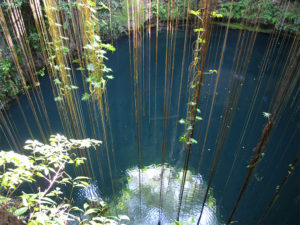
T
he first “tenant” of the cave was probably Cha’ak, a Maya deity with mythological attributes similar to Tlaloc. In Toltec mythology, the deity was the Lord of the Third Sun, whose roots go back to Teotihuacan and, farther in time, to Olmec cosmology.
This would explain Mexica-Toltec ceramics and Xipe Totec carved stone censers, the only archaeological artifacts found in the cave, to the exclusion of Cha’ak, Tlaloc Maya alter ego. The new comers settled in power centers and towns, while traditional Maya-Yucatec deities and gods remained unchanged in the countryside, as they are to this day.
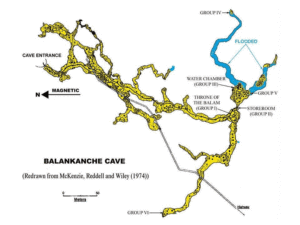
Balankanche’s surface mounds and remains of structures are seen scattered on site. The cave entrance, in the center of the complex, was surrounded by a 115+ ft/35mt circular tulum or fortified wall, 12ft/4m wide at the base and raised 4ft/1.3m above the rock base, surmounted by 6ft/2m of perishable material enclosure, now lost to time and weather. The reason for such a strong defensive wall is not known, and may pre-date Toltec arrival.
The cave entrance, located at the center of the circular walled area, may not be the location of the original, nor was it the only access. From ground level, steps take one down to a depth of 30ft/9m, then the corridor branches off.
The explored part of the cave is made up of more than a mile of passageways, that vary considerably in shape and size, from broad and flat, as much as 30ft/9m wide and 15ft/5m high, to narrow crawling spaces; others are no longer passable. The cave is divided into four groups, each with its particular, from Group.I to Group.VI. Archaeological data and remains beyond Group.IV have been mapped; few ceramic artifacts, complete or partially broken, have been recovered.
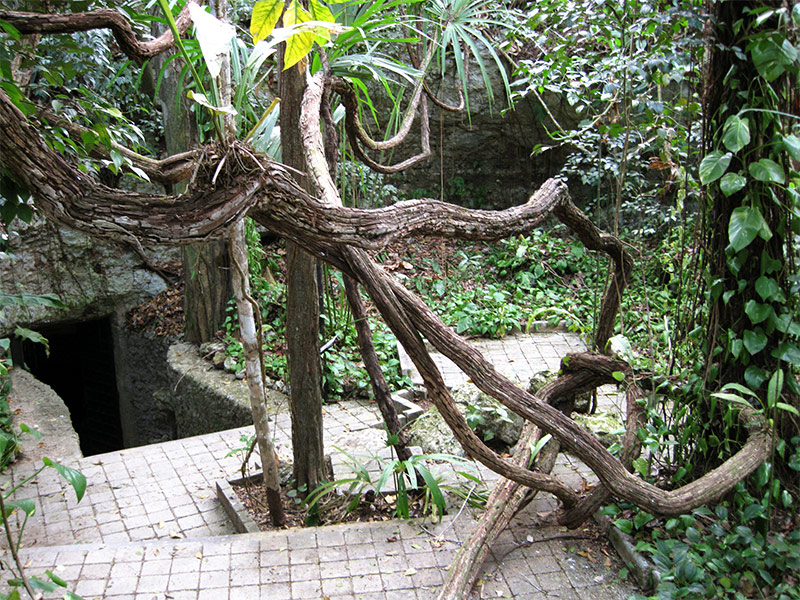
The corridors and steps for visitors are well built, maintained and made for easy walk, but there are limitations to admission in the cave.

The main corridors, the accessible parts of the cave, consist of more than a mile of passageways, that vary considerably in shape and size from broad and flat, as much as 30ft/9m wide to 15ft/5m high, or narrow to crawling spaces, others are no longer passable.
Sections of the main tunnels, some of which reach the water table at 70ft/22m beneath the surface in at least four places. Water depth vary with seasonal rains; cave access may be suspended subject to rains within the last hours. There is another corridor under the main one, half submerged and difficult of access.
The cave main chamber, Group.I, is a huge impressive circular room with thousands of stalagmites covering the ceiling. The floor naturally raises as a mound where massive twin columns, made of stalactite and stalagmite, meet at the center. Carved stone and ceramic effigy censers are set into cavities, and laid on the floor.
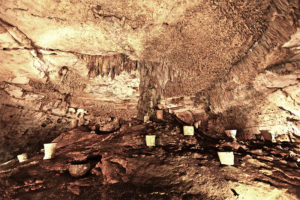
The cave is a strikingly beautiful work of nature; the high place of a culture now seen, and partly understood, through the foggy veil of time, that consigned its myths and beliefs in gods, deities and the ancestors, to the mineral world.
The central column is a reminder of the trunk of the Ceiba, the mythological “Tree of Life” set in the mineral world, with branches reaching to the heavens, while its roots are sunk deep into the underworld. The veneration of the “Altar of the Jaguar Priest”, E. Wyllis Andrews called the “Throne of the Tiger Priest”, can only be understood in the context of the vision of a dual perception of the world, and its concept of the field of opposites.
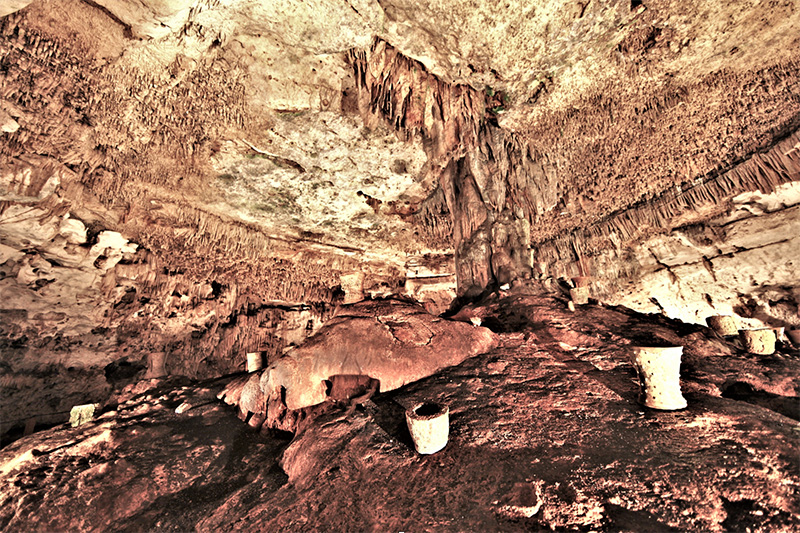
This impressive sanctuary created by nature but conceived by men as an altar for their god, Tlaloc, was walled in about 842AD during the Classic collapse. In 1959 were found large numbers of ceremonial ceramic and carved stone effigy censers, as well as mini-metates, set into cavities in the complex stalagmitic formation, as well as simply laid on the domed floor.
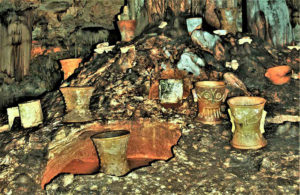
The ceramics on the “Altar” are representatives of two deities from the central plateau of Mexico, Tlaloc and Xipe Totec; none are Maya from the Yucatán.
Twenty nine large Tlaloc effigy censers and Xipe Totec stone censers were found on the Altar, together with mini-metates and manos, ceramic plates and other offerings, dated from Florescent 800-1000AD to Modified Florescent 1100-1200AD (+/-100). Female Maya deities, Chak’Chel and IxChel, patrons of childbirth, sexuality and fertility are present in the cave.
As a rule, Tlaloc ceramic censers are bi-conical 8>13in/19>34cm high and 8>12in/20>29cm in width; the upper conical component generally larger than the lower. The face of the deity was added after first firing in applique strips that formed a down curving mouth. The eyes are surrounded by circles, a characteristic specific to the deity, and slab ears and nose are added last.
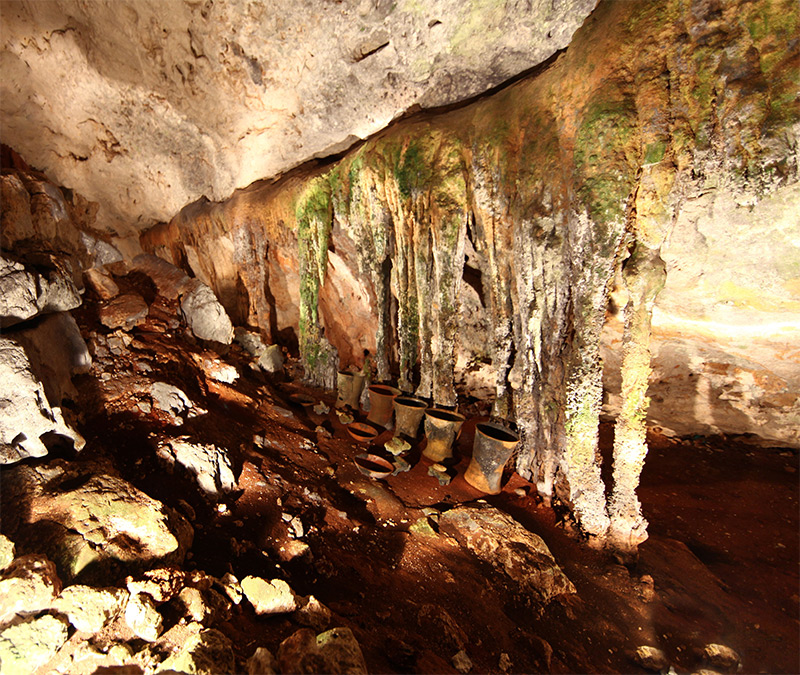
Group.II, is the “Altar of the Pristine Waters”; held a special place in rituals. Archaeoligists called the place the “store room”. At the foot of stalactite-stalagmite columns are found ceramic urns, set here to collect virgin water, or zuhuy’ha, that drips from stalactites above. Zuhuy’ha is viewed as the most sacred water in Maya rituals, since water collected from stalactites called the “Nipples of the Earth”, is sanctified because it never touches the ground and, being transferred directly from Nature to Culture, acquires the highest ritual value.
On the underground lakeshore is Group.IIIa with a peculiar arrangement of ceramic censers and plates, small spindle whorls, as well as stone mini metates, and manos; the largest offerings in the cave. How and why they were displayed is not known; nor the reason for the assemblage and their respective number. Their small size, particular to Tlaloc offerings and purposes, point to their use by small children and females.
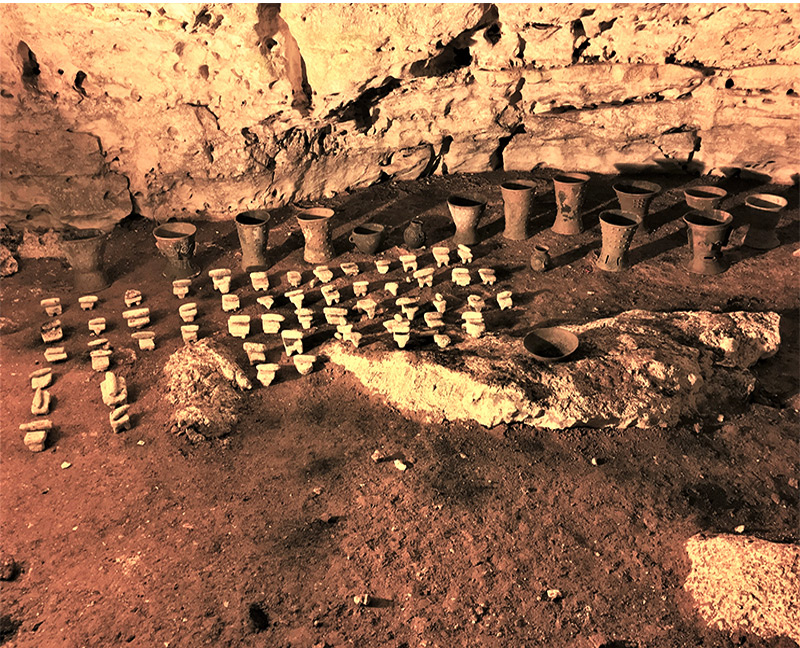
Ethnographic accounts throughout Mesoamerica document miniature objects as offerings, often associated with rain-making rituals. The female gender and young children were favored by Tlaloc, god of rain, lightning and thunder. The presence of spindle whorls underlines the symbolic significance of weaving that has been documented to be associated with females and ChakChel (great or red rainbow), God.C, the aged goddess of curing and child birth, in Classic times. She is known as Ix Chel (lady rainbow), from her shrines on the islands of Isla Mujeres and Cozumel. To the Maya, rainbows came from the underworld and were dreaded omens of illness and death (Sharer & Traxler,1994 :735).
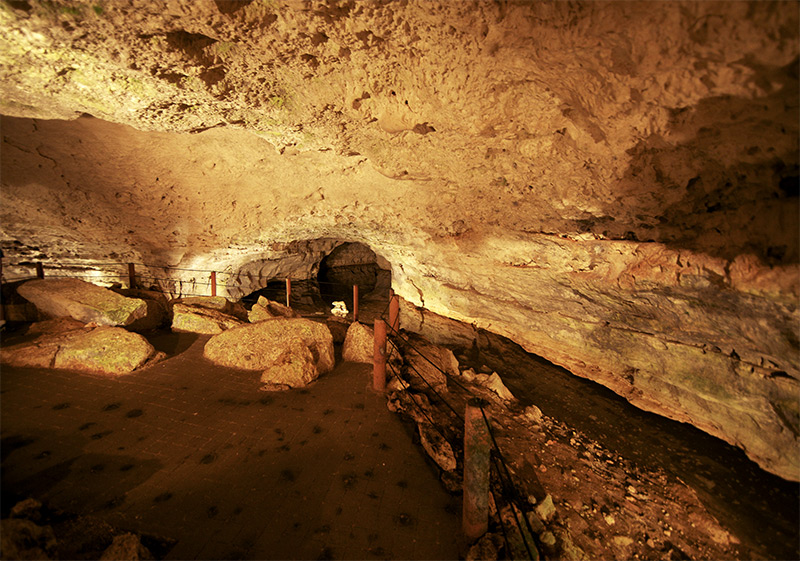
The “Waterway” is Group.IIIb, now mostly flooded, since it is at the top of the water table.The underground lake extends about 115ft/35m from the shore, then dips below the ceiling of the cave and turns northeast for another 330ft/100m, before rising again above the water table, and reach Group.IV, not accessible today.
Investigations found ceramics and stone censers in the water and on limestone outcrops. At the end of the elongated lake, is a chamber which seems to be the limit of human penetration in this direction. The average depth is 5 ft/1.5mt, with about half that depth in mud (E. Wyllys Andrews, 1970:12-13).
On the muddy floor of the waterway were scattered a number of offerings, such as Tlaloc effigy censers, studded censers and a variety of pottery offerings, with a distribution densest near the shore.
Caves are believed to be the birthplace where humans were born at the beginning of time, and returned at the end of their days. Ancestors dwell in caves, and are believed, together with gods and deities, to interact with the World Above. No less than the sacred earth, caves are believed to be the meeting grounds between humans and the divine.
Pyramids are the counter image of the cave, the World Below in the endless cycle of life. Each morning the rays of the Sun light the top of the pyramid first, the blessing of Culture by Nature and the powers vested in the lords and the priests by the gods, repeated daily.
Bibliography
Balankanche: Throne of the Tiger Priest – E. Wyllys Andrews IV, 1970
An Archaeological Guide to Mexico’s Yucatan Peninsula – Joyce Kelly, 1993
Maya History and Religion – J. Eric S. Thompson, 1970
Los Antiguos Mayas – Alberto Ruz Lhuillier, 1981
Ritual of the Bacabs – Ralph L. Roy, 1965













